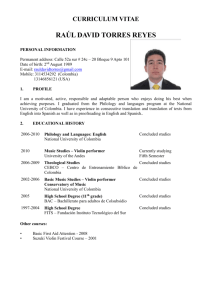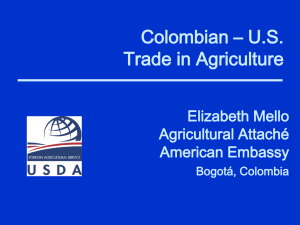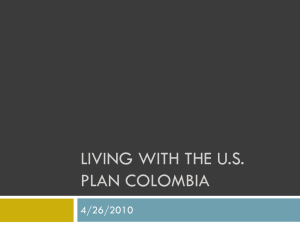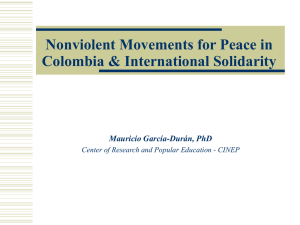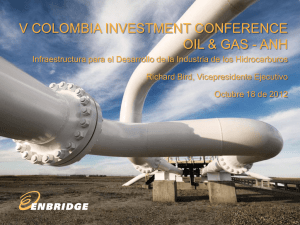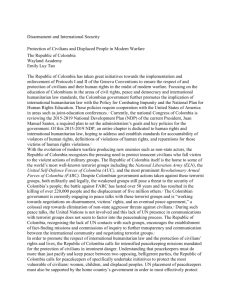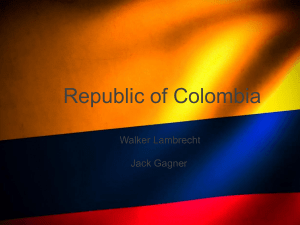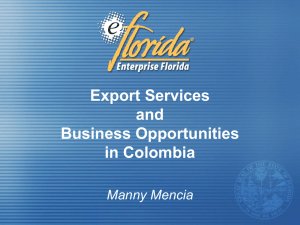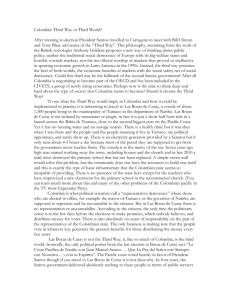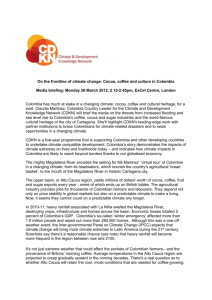National Symbols
advertisement
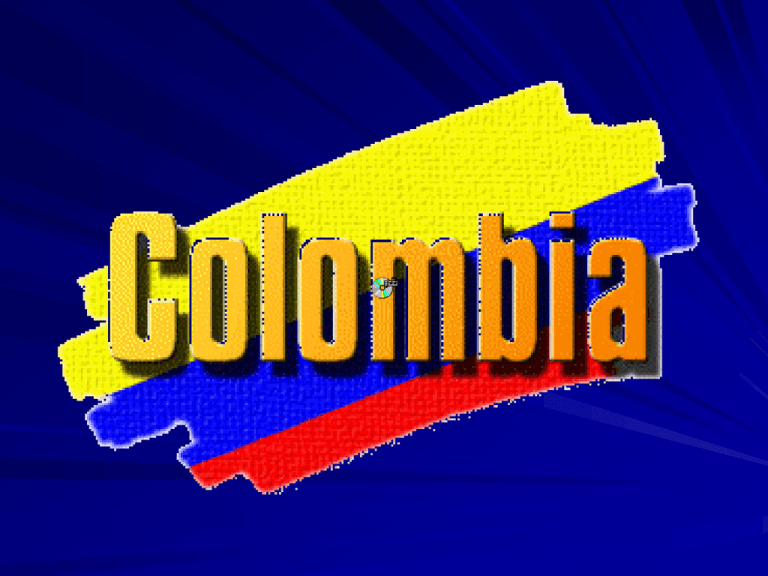
General information about COLOMBIA National Symbols Government Language Religion National Symbols: Shield of Colombia Flag of Colombia National Flower National Anthem COLOMBIA Geography GEOGRAPHY LOCATION Colombia is located in the Northwest Corner of South America. It’s size is 1,138,910 Square Kilometers. Colombia is the size of Texas and California combined COLOMBIA IN USA Borders North: The Caribbean Sea Northwest: Panama East: Venezuela and Brazil South: Ecuador and Peru West: The Pacific Ocean Atlantic Ocean Pacific Ocean The Only Country in South America with coasts on both Oceans Los Andes Mountain Range Has a Great Influence on its Geography, Weather and Ecosystems Los Andes Splits into Three Mountain Chains “Cordillera Occidental”: The lowest and shortest of the three mountain chains. “Cordillera Central”: The most populated and highest. “Cordillera Oriental”: The longest. That Divide The Country into Five Natural Areas Region Andina: The most important area with 70% of the population of the country. Region Caribe: Most of the country's commerce moves through this area. Region Pacifica: One of the wettest regions in the world. Region Orinoquia: Known as the eastern plains, where cattle raising is practiced. Region Amazonica: The natural reserve of the country. Biodiversity In Colombia you can find 10% of the Fauna and Flora of the Planet Our country holds the first place in the world for its great variety of butterflies, palm trees, orchids and amphibians It holds the second place in the world for its variety of plants It holds the third place in the world for its variety of reptiles Colombia Has Several Rivers Grouped in Four Basins Caribbean Basin Pacific Basin Orinoquia Basin Amazonian Basin Historically, The Two Most Important Rivers Have Been: The Magdalena River with a 1.550 Km length and The Cauca River with a 1.349 Km length. History of COLOMBIA The History of Colombia is Divided into Four Important Periods The Pre-Columbian Period (12.000 BC-1492) The Conquest Period (1500 – 1550) The Settlement Period (1550 – 1810) La Republic Period (1810 – Hoy) The Pre-Columbian Period (12.000 BC-1492) At the time of European contact, peoples from eastern South America, the Caribbean and Central America occupied Colombia. Most of these societies fiercely resisted Spanish colonization. Los Muiscas The most numerous of Colombia’s indigenous peoples were the Muisca. El Dorado It’s the most famous Colombian indigenous legend. It probably comes from a Muisca ceremony, in which a new ruler was covered with gold dust each year, and then washed in a sacred lake. Although many conquerors tried to find it, it was never found. The Conquest Period (1500 – 1550) The first cities in the “New World” were founded by Spanish conquerors. The Colonial Period (1550 – 1810) “Criollos”: Spanish descent born Colonial society relied on "purity of blood" as a basis for stratification: “Peninsulares”: persons of Spanish descent born in Spain; in the colonies; “Mestizos”: persons of mixed Spanish and Indian descent who were free but relegated to positions of low prestige. Black African slaves and “Zambos”: persons of mixed African and Indian descent, who were at the bottom of the social scale and were important only as a source of labor. The Republic Period (1810 – To Date) Simon Bolivar organized and led military forces to free the northern portion of South America from Spanish rule. Colombian Independence Day: July 20th, 1810. Colombian people Population 43. Million Approx. – 58% Mestizos. (EuroNative) – 20% Mixture (Indian-Euro). – 14% Mulatto. – 4% Black – 3% Mixture (Black-Native). – 1% Native Americans. Education: 91.3% Men 91.7% women 91.5% Total (2000 est.). Elementary: 90.7% pop. Secondary: 61% Pop. University: 10.6% 2000 est Religion: 90% Roman Catholic, other 10%. Cities Bogota Bogota Capital District Population 8,350,000 5,261 people/km² Altitude of 2640 m (8660 ft) Temperature is about 14 °C (57 ° F) Area covers 384.3 km² 1222.5 km² Bogota MODERN OLD TRANSMILENIO TRANSMILENIO CULTURAL ACTIVITIES TEATRO COLON PLANETARIO JARDIN BOTANICO INTERNATIONAL EVENTS BOOK FAIR THEATER FESTIVAL BOGOTA FASHION TOURIST PLACES GOLD MUSEUM MONSERRATE NATIONAL MUSEUM PRESIDENTIAL PALACE Other Cities MEDELLIN CARTAGENA CALI BARRANQUILLA SANTA MARTA SAN AGUSTIN SANTA MARTA SNOW MOUNTAIN CABO DE LA VELA SALT CATHEDRAL RUIZ AND TOLIMA SNOW VOLCANOES GALLINERAL PARK TEQUENDAMA WATERFALL VILLA DE LEYVA TOWN TAYRONA NATURAL PARK AMAZONAS RIVER LAS LAJAS CATHEDRAL SAN ANDRES ISLAND The most famous Colombian Singers: Carlos Vives, Juanes & Shakira. Sports Economy Agriculture : 13.4% – Flowers – Coffee Industry: 32.1% – Clothing – Mining – Coal – Petroleum Services: – Tourism 54.5% Economy Exports: $15.5 billion f.o.b Commodities: Petroleum, coffee, coal, apparel, bananas, cut flowers Partners: US 42.1%, Venezuela 9.7%, Ecuador 6%. Imports: $15.34 billion f.o.b Commodities: industrial equipment, transportation equipment, consumer goods, chemicals, paper products, fuels, electricity . Partners: US 29.1%, Venezuela 6.5%, China 6.4%, Mexico 6.2%, Brazil 5.8%. Currency The official currency of Colombia is the PESO. 1 PESO = 100 centavos. There are coins in the following denominations: $5, $10, $20, $50, $100, $200 and $500 pesos. There are paper notes in the following denominations: $1,000, $2,000, $5,000, $10,000, 20,000 & 50,000 pesos. 1 Dollar = 2000 pesos. Industry Growth rate: 6%/07 Textiles, food processing, oil, clothing and footwear, beverages, chemicals, cement; gold, coal, emeralds. Agriculture Coffee, cut flowers, bananas, rice, tobacco, corn, sugarcane, cocoa beans, oilseeds, vegetables; forest products; shrimp Colombian Coffee •It is considered the ‘Richest' coffee in the world because is rich in flavor. •Colombia produces about 12% of the coffee in the world. •There are two main regions of coffee production in Colombia: Medellín, Armenia, and Manizales (MAM) in the central region and Bogotá and Bucaramanga in the eastern region. CRAFTS Services: Tourism: Us 350 7/D Eje cafetero, Cartagena, Santamarta, San Andres, Amazonas, Guajira. Other services: Education, health, technology, insurance and banking. Colombian Food Colombian Food is very rich and depends on the region. •Fruits (banana, passion fruit, kiwis, feijoas, guava, guanabana, coconut). •Vegetables: (potato, yuca, plantain,guineos and avocado) •Meat ( steak, fish, lamb, chiguiro, chivo and seafood) •Specials: Sancocho, mute, tamal, empanadas, salpicon, arepa, bocadillo, ayacos, ajiaco, fritanga ,patacones, etc. Thanks For learning about my country,

